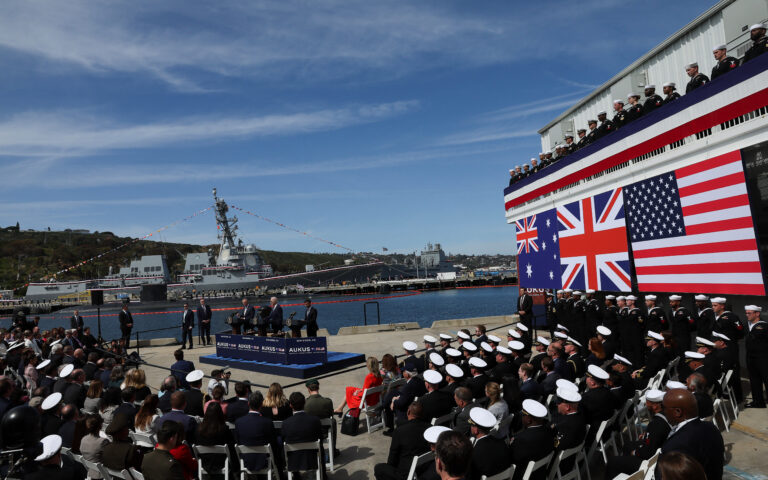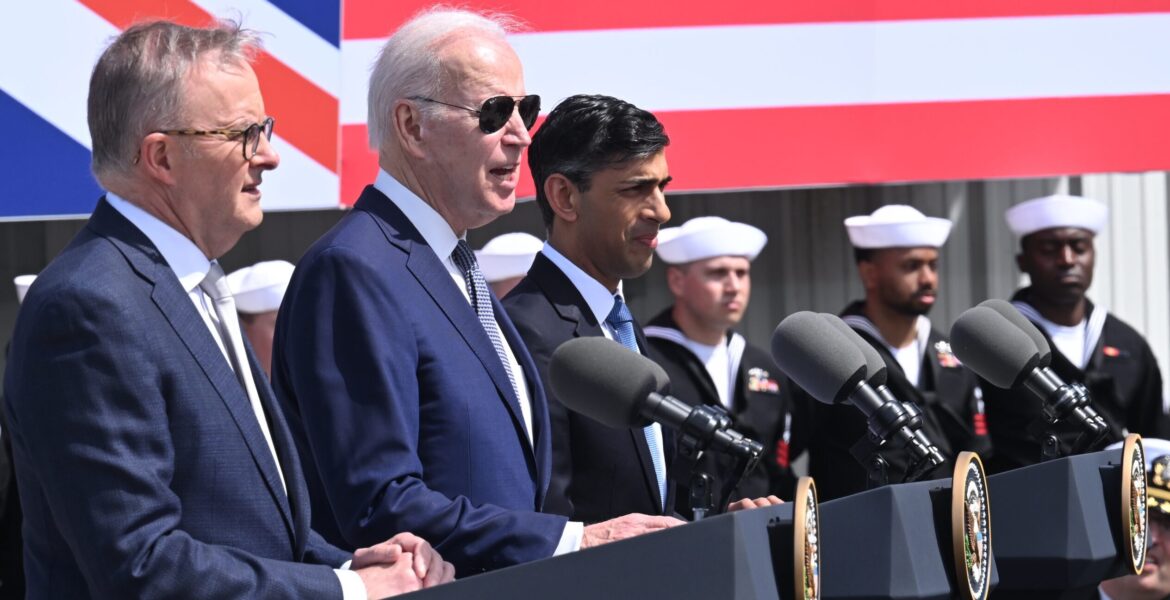Australia, with the backing of its British and American allies, is about to embark on one of its most expensive and geopolitically consequential military endeavour's in a century: the acquirement of nuclear-powered submarines with a forecast cost of $268bn to $368bn between now and the mid 2050s.
As part of the multidecade nuclear-powered submarine plan unveiled on Tuesday, Australian taxpayers will pour “substantial” funds into expanding American shipbuilding capacity, understood to be about $3bn in the first four years.
Australia’s prime minister, Anthony Albanese, said Aukus plan marked “a new chapter” in the relationship between the three countries, as he joined the US president, Joe Biden, and the UK prime minister, Rishi Sunak, for the announcement in San Diego.

“The Aukus agreement we confirm here in San Diego represents the biggest single investment in Australia’s defence capability in our history,” Albanese said.
Without directly naming China as a source of concern, Albanese said the plan reflected a shared determination to ensure all countries could “act in their sovereign interests free from coercion”.
He said his government was “also determined to promote security by investing in our relationships across our region”.
In a bid to reassure partners across the Indo-Pacific, Biden said it was important to note the Australian submarines would be nuclear-powered, not nuclear-armed.
“I want to be clear from the outset – right off the bat – so there’s no confusion or misunderstanding on this critical point,” Biden said. “Australia is a proud non-nuclear weapons state, and it’s committed to stay that way.”
Australia would invite “rotational forces” of US and UK submarines to visit the country from 2027.

The first Australian-built nuclear-powered submarines, fitted with vertical launch systems to fire cruise missiles, are due to enter into service in the early 2040s.
The British-designed submarine “will incorporate US technology such as propulsion plant systems and components, a common vertical launch system and weapons”, an Australian government fact sheet said. “The Aukus partners will also develop a joint combat system as an expansion of the US-Australia combat system.”
The plan begins with increased visits by US submarines to Australian ports this year.
Sign up for Guardian Australia’s free morning and afternoon email newsletters for your daily news roundup
From 2027 at the earliest, the UK and the US plan to establish a rotational presence of one UK Astute class submarine and up to four US Virginia class submarines at HMAS Stirling near Perth, Western Australia.
This will be called “Submarine Rotational Force-West” (SRF-West). The Australian government argues this rotational presence “will comply fully with Australia’s longstanding position of no foreign bases on its territory” because these submarines will be rotated through the location and will not be permanently based in Australia.
The three countries argue the rotational presence will “put our nations shoulder to shoulder as Australia builds the necessary operational capabilities and skills to steward and operate its own fleet of nuclear-powered submarines”.
The US and UK submarines would operate as sovereign assets under the command of, respectively, American and British commanders, but there would be “a significant degree of coordination in their activities”, a senior Biden administration official said.
Beginning in the early 2030s, the US intends to sell Australia three Virginia class submarines, with the potential to sell up to two more if needed, pending approval from the US Congress.
The three governments argue this is “critical to continue growing Australia’s ability to own and operate” a fleet of nuclear-powered submarines and to ensure Australia does not experience any capability gap when its Collins class diesel-electric submarines are retired from the 2030s. The Australian government still plans to extend the life of some of these six conventional submarines, but the Aukus plans means it may not be necessary to carry out expensive upgrades on all of them.
The third phase of the program involves the design and construction of a submarine to be known as the “SSN Aukus”, to be based on a UK design but incorporate US technology – as the Guardian foreshadowed last week.
“Australia’s long-term submarine will be a state-of-the-art platform that uses the best of US, UK and Australian technologies,” the official said.
“SSN Aukus will be built and deployed by both Australia and the UK. The United Kingdom intends to deliver its first SSN Aukus domestically in the late 2030s. Australia intends to deliver the first SSN Aukus built in Australia to the Royal Australian Navy in the early 2040s.
“This is going to require significant improvements in industrial bases in all three countries.”
Senior Biden administration officials said the budget commitment from Australia towards the US industrial base was “another manifestation of just how serious and critical this effort is”. The $3bn would help the US reduce work backlogs on its own Virginia class submarines, and expand its production ability.
The funding for US domestic production could be a point of tension in Australia at a time when the budget is facing pressure on multiple fronts.
The projected cost includes includes $9bn over the initial four-year budget period, or an increase of $3bn compared with the $6bn earmarked for the abandoned French project. Defence is being asked to offset that $3bn, which could come through changes to other defence projects.
Australian officials believe it is hard to estimate the cost over the life of the program, but have predicted a range based on all costs including acquisition and sustainment.
The long-term cost of the submarine plan is likely to be about 0.15% of Australia’s gross domestic product per year on average, compared with Labor’s pre-election overall pledge to spend at least 2% of GDP on defence annually.
The Coalition’s defence spokesperson, Andrew Hastie, earlier offered bipartisan support to the overall Aukus deal, saying it is “truly a multigenerational nation-building task for the Australian people” and that it “cannot fail”.
Hastie also acknowledged the Aukus project would require some “hard choices” in the budget because “money doesn’t grow on trees”.
READ MORE: China is winning Turkish hearts and minds following the earthquake, survey finds.

